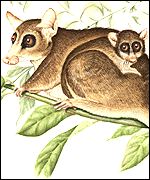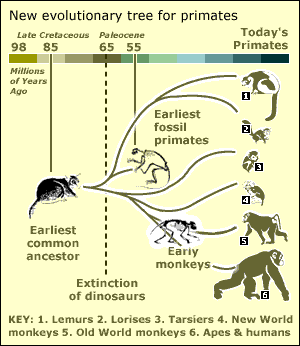The Primate Family Tree or
Primate Evolutionary Tree
Existing primate species can be divided into six subgroups: lemurs, lorises, tarsiers, New World monkeys, Old World monkeys,
and apes and humans.
As reported in an article in the well-respected scientific magazine "Nature" in April, 2002 the
results of researches led by the Field Museum of Chicago have resulted in a revision of the primates evolutionary
tree.
The origin of primates has been pushed back from 65
million years ago to 85 million years ago, before the dinosaurs became
extinct.
 According to Dr. Martin vice president of academic affairs at The Field Museum and co-author of the research, who has studied primate evolution from many different perspectives for the past
30 years, their 85-million-year-old earliest common ancestor probably looked like a primitive, small-brained version of today's
dwarf lemur.
According to Dr. Martin vice president of academic affairs at The Field Museum and co-author of the research, who has studied primate evolution from many different perspectives for the past
30 years, their 85-million-year-old earliest common ancestor probably looked like a primitive, small-brained version of today's
dwarf lemur.
That animal would probably have been a nocturnal, tree-living creature weighing about 1-2 pounds, with grasping
hands and feet, also used by the infant to cling to the mother's fur. It probably had large forward-facing eyes
for stereovision and a shortened snout. It would have inhabited tropical/subtropical forests, feeding on a mixed
diet composed mainly of fruit and insects. Like humans, it probably had a slow pace of breeding characterized
by heavy investment in a relatively small number of offspring.
The illustration above left was prepared by Nancy Klaud to accompany the Field Museum's research findings.

Credit: © The Field Museum, D. Quednau.
The sciences hold that there were many naturally occuring changes in physique and behaviour - some of these proved beneficial in terms
of survival - and were locally reinforced by such "successes-in-survival" allowing several branching divergences,
based on these survival-favouring changes,
to produce a primate evolutionary tree of related species.
The changes that allowed Humans to feature as part of a human / primate family tree, and which allowed Humanity
to become established as
we know it today, being very slowly accumulated due to various "survival advantages" that these changes
conferred allowing their possessors to be more generally successful in the struggle for life but particularly
so in the gaining of foodstuffs to nourish themselves, their families, and their friends.

At age-of-the-sage we are more truly interested in the origins of Human Psychology
and Spirituality than in the origins
of Human Physique.
|
|
![[primate family tree primate evolutionary tree]](evolution.gif)
![[primate family tree primate evolutionary tree]](evolution.gif)